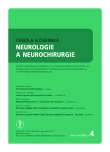Unilateral Basal Ganglia Hypoplasia in a Patient with Epilepsy – a Case Report
Authors:
M. Kaiserová 1; E. Čecháková 2; R. Mařák 3; M. Šmídová 4; K. Farníková 1; P. Kaňovský 1
Authors‘ workplace:
FN Olomouc
Centrum pro diagnostiku a léčbu neurodegenerativních onemocnění, Neurologická klinika LF UP v Olomouci
1; FN Olomouc
Radiologická klinika LF UP v Olomouci
2; FN Olomouc
Centrum pro epilepsie, Neurologická klinika LF UP v Olomouci
3; FN Olomouc
Oddělení klinické psychologie
4
Published in:
Cesk Slov Neurol N 2010; 73/106(4): 430-433
Category:
Case Report
Overview
The occurrence of a larger basal ganglia lesion without motor disorder, behavioural abnormality or disturbance of speech is exceedingly rare; only one case appears in the relevant literature. We report a second case of a patient with unilateral hypoplasia of the basal ganglia without motor impairment, who suffered from temporal lobe epilepsy. We hypothesize damage to the right basal nuclei at an early stage in the development of the brain. Neuronal plasticity at this stage of development might have been responsible for the normal motor function acquired. We also hypothesize that the basal ganglia have a weak inhibitory effect on the further spread of epileptic activity, which might have helped facilitate the development of temporal lobe epilepsy.
Key words:
basal ganglia – motor function – temporal lobe epilepsy
Sources
1. Bhatia KP, Marsden CD. The behavioural and motor consequences of focal lesions of the basal ganglia in man. Brain 1994; 117 (Pt 4): 859–876.
2. DeLong GR. Mid-gestation right basal ganglia lesion: clinical observations in two children. Neurology 2002; 59(1): 54–58.
3. Mercuri E, Barnett A, Rutherford M, Guzzetta A, Haataja L, Cioni G et al., Neonatal cerebral infarction and neuromotor outcome at school age. Pediatrics 2004; 113 (1): 95–100.
4. Kellinghaus C, Montgomery E, Neme S, Ruggieri P, Lüders HO. Unilateral absence of the basal ganglia plus epilepsy without motor symptoms. Neurology 2003; 60(5): 870–873.
5. Hazrati LN, Parent A. Contralateral pallidothalamic and pallidotegmental projections in primates: an anterograde and retrograde labeling study. Brain Res 1991; 567(2): 212–223.
6. Christensen J, Sørensen JC, Ostergaard K, Zimmer J. Early postnatal development of the rat corticostriatal pathway: an anterograde axonal tracing study using biocytin pellets. Anat Embryol (Berl) 1999; 200(1): 73–80.
7. Tasch E, Cendes F, Li LM, Dubeau F, Andermann F, Arnold DL. Neuroimaging evidence of progressive neuronal loss and dysfunction in tempoval lobe epilepsy. Ann Neurol 1999; 45(5): 568–576
8. Seidenberg M, Kelly KG, Parrish J, Geary E, Dow C, Rutecki P et al. Ipsilateral and contralateral MRI Volumetric Abnormalities in chronic unilateral temporal lobe epilepsy and thein clinical correlates. Epilepsia 2005; 46(3): 420–430.
9. Pulsipher DT, Seidenberg M, Morton JJ, Geary E, Parrish J, Hermann B. MRI volume loss of subcortical structures in unilateral temporal lobe epilepsy. Epilepsy Behav 2007; 11(3): 442–449.
10. Rektor I, Kuba R, Brázdil M. Interictal and Ictal EEG Activity in the Basal Ganglia: An SEEG Study in Patients with Temporal Lobe Epilepsy. Epilepsia 2002; 43(3): 253–262.
11. Dematteis M, Kahane P, Vercueil L, Depaulis A. MRI evidence for the involvement of basal ganglia in epileptic seizures: an hypothesis. Epileptic Disord 2003; 5(3): 161–164.
Labels
Paediatric neurology Neurosurgery NeurologyArticle was published in
Czech and Slovak Neurology and Neurosurgery

2010 Issue 4
- Metamizole vs. Tramadol in Postoperative Analgesia
- Memantine in Dementia Therapy – Current Findings and Possible Future Applications
- Memantine Eases Daily Life for Patients and Caregivers
- Metamizole at a Glance and in Practice – Effective Non-Opioid Analgesic for All Ages
- Advances in the Treatment of Myasthenia Gravis on the Horizon
Most read in this issue
- Dynamic Magnetic Resonance Imaging of a Lumbar Spine – a Case Report
- Pharmacological Approaches to the Treatment of Epilepsy
- Treatment of Juxtafacet Cyst of the Lumbar Spine by Dynamic Interspinous Stabilization – a Case Report
- Functional Significance of a Temporal Lobe
